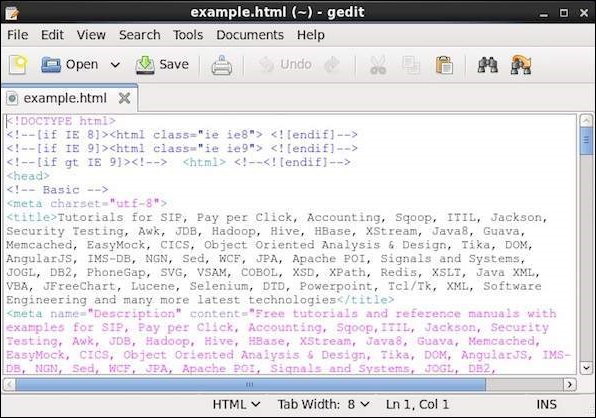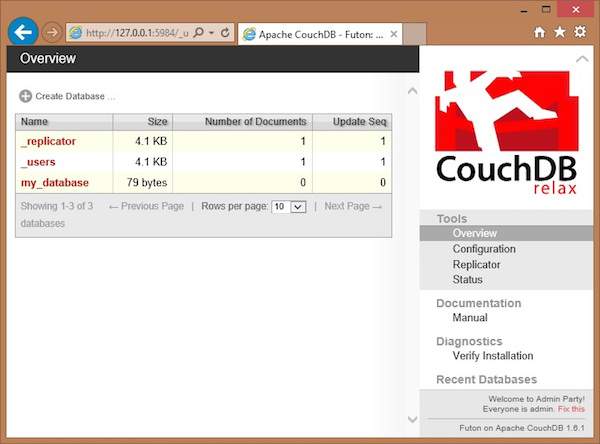CouchDB – Curl & Futon
CouchDB – Curl & Futon
卷曲实用程序
cURL 实用程序是一种与 CouchDB 通信的方式。
它是一种使用支持的协议之一(HTTP、HTTPS、FTP、FTPS、TFTP、DICT、TELNET、LDAP 或 FILE)从服务器或向服务器传输数据的工具。该命令旨在无需用户交互即可工作。cURL 提供了大量有用的技巧,例如代理支持、用户身份验证、ftp 上传、HTTP 发布、SSL (https:) 连接、cookie、文件传输恢复等等。
cURL 实用程序可用于 UNIX、Linux、Mac OS X 和 Windows 等操作系统。它是一个命令行实用程序,用户可以使用它直接从命令行访问 HTTP 协议。本章教您如何使用 cURL 实用程序。
使用 cURL 实用程序
您可以使用 cURL 实用程序访问任何网站,只需输入 cURL 后跟网站地址,如下所示 –
curl www.tutorialspoint.com/
默认情况下,cURL 实用程序返回所请求页面的源代码。它在终端窗口上显示此代码。
cURL 实用程序选项
cURL 实用程序提供了各种可使用的选项,您可以在 cURL 实用程序帮助中查看它们。
以下代码显示了 cURL 帮助的某些部分。
$ curl --help
Usage: curl [options...] <url>
Options: (H) means HTTP/HTTPS only, (F) means FTP only
--anyauth Pick "any" authentication method (H)
-a/--append Append to target file when uploading (F/SFTP)
--basic Use HTTP Basic Authentication (H)
--cacert <file> CA certificate to verify peer against (SSL)
-d/--data <data> HTTP POST data (H)
--data-ascii <data> HTTP POST ASCII data (H)
--data-binary <data> HTTP POST binary data (H)
--data-urlencode <name=data/name@filename> HTTP POST data
urlencoded (H)
--delegation STRING GSS-API delegation permission
--digest Use HTTP Digest Authentication (H)
--disable-eprt Inhibit using EPRT or LPRT (F)
--disable-epsv Inhibit using EPSV (F)
-F/--form <name=content> Specify HTTP multipart POST data (H)
--form-string <name=string> Specify HTTP multipart POST data (H)
--ftp-account <data> Account data to send when requested by server
(F)
--ftp-alternative-to-user <cmd> String to replace "USER [name]" (F)
--ftp-create-dirs Create the remote dirs if not present (F)
--ftp-method [multi cwd/no cwd/single cwd] Control CWD usage (F)
--ftp-pasv Use PASV/EPSV instead of PORT (F)
-G/--get Send the -d data with a HTTP GET (H)
-H/--header <line> Custom header to pass to server (H)
-I/--head Show document info only
-h/--help This help text
--hostpubmd5 <md5> Hex encoded MD5 string of the host public key.
(SSH)
-0/--http1.0 Use HTTP 1.0 (H)
--ignore-content-length Ignore the HTTP Content-Length header
-i/--include Include protocol headers in the output (H/F)
-M/--manual Display the full manual
-o/--output <file> Write output to <file> instead of stdout
--pass <pass> Pass phrase for the private key (SSL/SSH)
--post301 Do not switch to GET after following a 301
redirect (H)
--post302 Do not switch to GET after following a 302
redirect (H)
-O/--remote-name Write output to a file named as the remote file
--remote-name-all Use the remote file name for all URLs
-R/--remote-time Set the remote file's time on the local output
-X/--request <command> Specify request command to use
--retry <num> Retry request <num> times if transient problems
occur
--retry-delay <seconds> When retrying, wait this many seconds
between each
--retry-max-time <seconds> Retry only within this period
-T/--upload-file <file> Transfer <file> to remote site
--url <URL> Set URL to work with
-B/--use-ascii Use ASCII/text transfer
在与 CouchDB 通信时,广泛使用了 cURL 实用程序的某些选项。以下是 cURL 实用程序的一些重要选项的简要说明,包括 CouchDB 使用的选项。
-X 标志
(HTTP) 指定与 HTTP 服务器通信时使用的自定义请求方法。使用指定的请求而不是其他使用的方法(默认为 GET)。阅读 HTTP 1.1 规范以获取详细信息和说明。
(FTP) 指定使用 ftp 进行文件列表时要使用的自定义 FTP 命令而不是 LIST。
-H
(HTTP) 获取网页时使用额外的标头。请注意,如果您添加的自定义标头与 cURL 将使用的内部标头之一同名,则将使用外部设置的标头而不是内部标头。这使您可以进行比 cURL 通常更棘手的工作。您不应该在不完全了解您在做什么的情况下替换内部设置的标头。用冒号右侧没有内容的内部标题替换内部标题,将阻止该标题出现。
cURL 确保您添加/替换的每个标头都使用正确的行尾标记发送。您既不应将其添加为标题内容的一部分,也不应添加换行符或回车来使内容混乱。
另请参阅 -A/–user-agent 和 -e/–referer 选项。
此选项可以多次使用以添加/替换/删除多个标题。
-d 标志
使用 cURL 的这个标志,您可以将数据与 HTTP POST 请求一起发送到服务器,就好像它是由用户在表单中填写并提交的一样。
例子
假设有一个网站,您想登录它或使用 cURL 实用程序的 -d 标志向该网站发送一些数据,如下所示。
curl -X PUT http://mywebsite.com/login.html -d userid=001 -d password=tutorialspoint
它发送一个看起来像“userid=001&password=tutorialspoint”的帖子块。同样,您也可以使用 -d 标志发送文档 (JSON)。
-o 标志
使用此标志,cURL 将请求的输出写入文件。
例子
以下示例显示了cURL 实用程序的-o标志的使用。
$ curl -o example.html www.tutorialspoint.com/index.htm
% Total % Received % Xferd Average Speed Time Time Time Current
Dload Upload Total Spent Left Speed
100 81193 0 81193 0 0 48168 0 --:--:-- 0:00:01 --:--:--
58077
这将获取tutorialspoint.com 主页的源代码,创建一个名为example.com 的文件并将输出保存在名为example.html 的文件中。
以下是example.html的快照。

-O
这个标志类似于-o,唯一的区别是这个标志,一个与请求的 url 同名的新文件被创建,并且被请求的 url 的源代码将被复制到其中。
例子
以下示例显示了cURL 实用程序的-O标志的使用。
$ curl -O www.tutorialspoint.com/index.htm
% Total % Received % Xferd Average Speed Time Time Time Current
Dload Upload Total Spent Left
Speed
100 81285 0 81285 0 0 49794 0 --:--:-- 0:00:01 --:--:--
60077
它会创建一个名为 index.htm 的新文件,并将 tutorialspoint.com 的索引页面的源代码保存在其中。
你好沙发数据库
您可以通过向安装的 CouchDB 实例发送 GET 请求来访问 CouchDB 的主页。首先确保你已经在你的 Linux 环境中安装了 CouchDB 并且它运行成功,然后使用以下语法向 CouchDB 实例发送 get 请求。
curl http://127.0.0.1:5984/
这会为您提供一个 JSON 文档,如下所示,其中 CouchDB 指定了详细信息,例如版本号、供应商名称和软件版本。
$ curl http://127.0.0.1:5984/
{
"couchdb" : "Welcome",
"uuid" : "8f0d59acd0e179f5e9f0075fa1f5e804",
"version" : "1.6.1",
"vendor" : {
"name":"The Apache Software Foundation",
"version":"1.6.1"
}
}
所有数据库的列表
您可以通过发送 get 请求和字符串“_all_dbs string “来获取所有创建的数据库的列表。以下是获取 CouchDB 中所有数据库列表的语法。
curl -X GET http://127.0.0.1:5984/_all_dbs
它为您提供 CouchDB 中所有数据库的列表,如下所示。
$ curl -X GET http://127.0.0.1:5984/_all_dbs [ "_replicator" , "_users" ]
创建数据库
您可以使用带有 PUT 标头的 cURL 使用以下语法在 CouchDB 中创建数据库 –
$ curl -X PUT http://127.0.0.1:5984/database_name
例子
例如,使用上面给出的语法创建一个名为my_database的数据库,如下所示。
$ curl -X PUT http://127.0.0.1:5984/my_database
{"ok":true}
确认
通过列出所有数据库来验证是否创建了数据库,如下所示。在这里你可以观察到新创建的数据库名称,“my_database”在列表中
$ curl -X GET http://127.0.0.1:5984/_all_dbs [ "_replicator " , "_users" , "my_database" ]
获取数据库信息
您可以使用 get 请求以及数据库名称来获取有关数据库的信息。以下是获取数据库信息的语法。
例子
例如,让我们获取名为my_database的数据库的信息,如下所示。您可以在此处获取有关您的数据库的信息作为响应。
$ curl -X GET http://127.0.0.1:5984/my_database
{
"db_name" : "my_database",
"doc_count" : 0,
"doc_del_count" : 0,
"update_seq" : 0,
"purge_seq" : 0,
"compact_running" : false,
"disk_size" : 79,
"data_size" : 0,
"instance_start_time" : "1423628520835029",
"disk_format_version" : 6,
"committed_update_seq" : 0
}
被褥
Futon 是 CouchDB 的内置、基于 Web 的管理界面。它提供了一个简单的图形界面,您可以使用它与 CouchDB 进行交互。它是一个简单的界面,它提供对所有 CouchDB 功能的完全访问。以下是这些功能的列表 –
数据库 –
- 创建数据库。
- 破坏数据库。
文件 –
- 创建文档。
- 更新文档。
- 编辑文档。
- 删除文档。
开始被褥
确保 CouchDB 正在运行,然后在浏览器中打开以下网址 –
http://127.0.0.1:5984/_utils/
如果您打开此网址,它将显示蒲团主页,如下所示 –

-
在此页面的左侧,您可以观察到 CouchDB 的所有当前数据库的列表。在这个插图中,我们有一个名为my_database的数据库,以及系统定义的数据库_replicator和_user。
-
在右侧,您可以看到以下内容 –
-
工具– 在本节中,您可以找到Configuration来配置 CouchDB,Replicator来执行复制,以及Status来验证 CouchDB 的状态和最近在 CouchDB 上所做的修改。
-
文档– 本节包含 CouchDB 最新版本的完整文档。
-
诊断– 在此您可以验证 CouchDB 的安装。
-
最近的数据库– 在此之下,您可以找到最近添加的数据库的名称。
-
